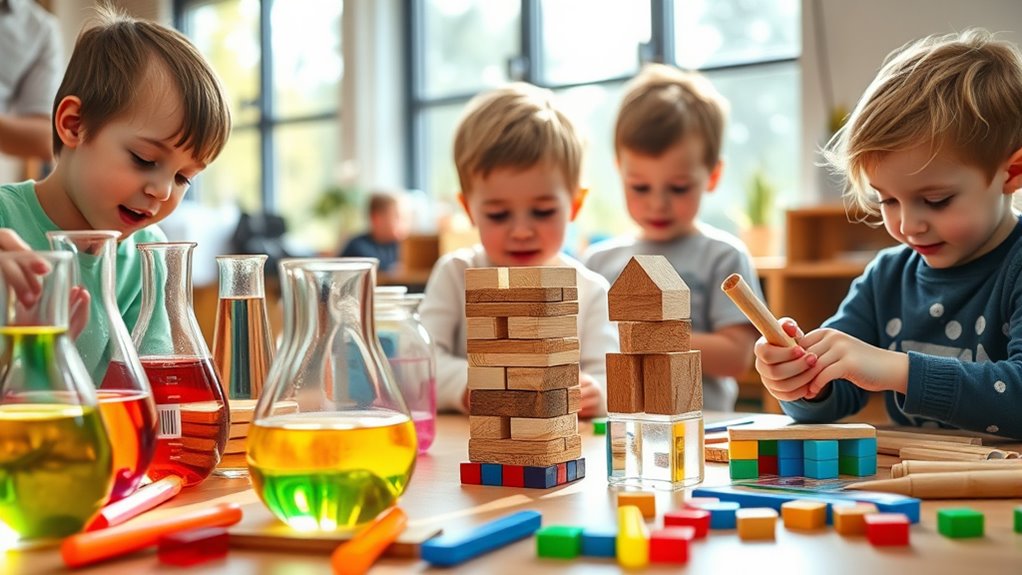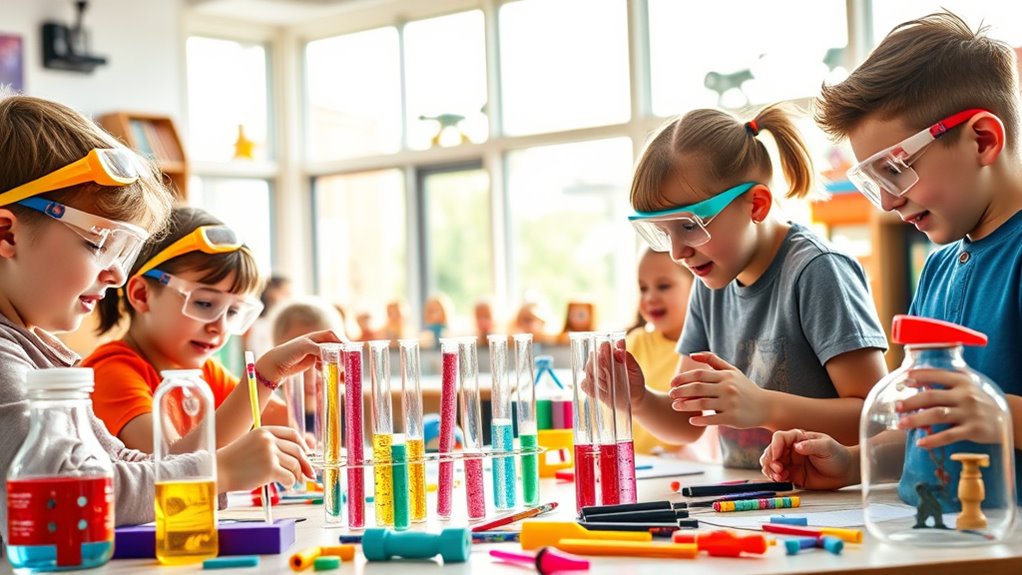Learning through experimentation and play allows you to foster active exploration, spark curiosity, and build essential skills like problem-solving and confidence. When you encourage hands-on activities, children develop fine motor skills, resilience, and independence while making learning enjoyable. Creating a safe environment for tinkering and building helps them learn from mistakes and refine their ideas. Keep exploring these strategies to see how engaging play can transform learning into an exciting journey.
Key Takeaways
- Hands-on activities promote active exploration, curiosity, and deeper understanding through tactile and engaging experiences.
- Experimentation fosters creativity, problem-solving skills, and adaptability by allowing children to test ideas and learn from mistakes.
- Play-based learning builds confidence, independence, and critical thinking, empowering children as capable learners.
- Activities that develop fine motor skills enhance physical coordination, patience, and perseverance alongside cognitive growth.
- Creating a safe learning environment ensures responsible experimentation while encouraging curiosity and responsible exploration.

Learning through experimentation and play is an essential way for children to develop critical skills and deepen their understanding of the world around them. When you encourage kids to engage in hands-on activities, you give them opportunities to explore concepts actively rather than passively absorbing information. These activities foster curiosity, problem-solving, and resilience, all indispensable components of lifelong learning. Through tactile experiences, children learn by doing, which helps solidify their understanding more effectively than traditional rote memorization.
Hands-on activities serve as a gateway to creative exploration. When children manipulate objects, experiment with materials, or build something from scratch, their imaginations are stimulated, and their minds become more adaptable. For example, constructing a simple machine with everyday items not only teaches engineering principles but also encourages innovative thinking. This type of learning is dynamic; it invites children to test ideas, learn from mistakes, and refine their approaches. As they experiment, they grasp complex concepts in a way that feels natural and engaging, making learning both enjoyable and meaningful.
Creative exploration within hands-on activities also promotes independence and confidence. When you allow children to take the lead, they learn to trust their judgment and develop problem-solving skills. For instance, encouraging them to design a science project or create an art piece pushes them to think critically about their choices and outcomes. Such activities empower children to see themselves as capable learners who can discover solutions on their own. Plus, they foster an intrinsic motivation to explore new ideas, which is indispensable for nurturing a growth mindset.
Furthermore, hands-on activities and creative exploration help children develop fine motor skills and hand-eye coordination. Whether they’re cutting, painting, assembling models, or experimenting with different textures, they refine their physical skills in tandem with their cognitive development. These activities also promote patience and perseverance, as children learn to focus on completing a task or solving a problem despite obstacles or initial failure. Additionally, incorporating security awareness into their learning environment can teach children about safety and responsibility as they explore new tools and materials.
Frequently Asked Questions
How Can Parents Effectively Encourage Risky Play Safely?
To encourage risky play safely, you should implement effective supervision strategies that allow your child to explore while minimizing danger. Practice risk management by setting clear boundaries and inspecting play areas for hazards. Stay nearby to monitor activities without being overly restrictive. Encourage your child to assess risks themselves, fostering confidence and decision-making skills. By balancing supervision with freedom, you enable safe risky play that promotes learning and resilience.
What Age Is Best Suited for Introducing Experimental Activities?
Think of childhood as a garden bursting with potential—around ages 2 to 7, your child is perfectly suited for introducing experimental activities. During this time, sensorimotor development flourishes, fueling creative exploration. You can confidently encourage risk-taking, knowing their curiosity is blossoming. This stage’s natural enthusiasm to explore helps them learn through hands-on experiences, laying a sturdy foundation for future learning and resilience.
How Do Cultural Differences Influence Learning Through Play?
Cultural differences markedly influence how you approach learning through play. Cultural norms shape what activities are encouraged or discouraged, affecting children’s engagement. Play stereotypes may lead you to perceive certain play styles as more acceptable, limiting exploration. You can foster inclusive learning by understanding these variations, encouraging children to explore diverse types of play regardless of cultural expectations. Embracing this diversity helps children develop creativity and adaptability in their learning journey.
Can Technology Enhance Learning Through Experimentation?
Yes, technology can enhance learning through experimentation. You can use interactive simulations to explore complex concepts hands-on, making learning more engaging and effective. Creative coding allows you to design your experiments, fostering problem-solving skills and innovation. By combining these tools, you create an immersive environment where curiosity drives discovery, helping you learn through active participation, experimentation, and play, which deepens understanding and sparks creativity.
How Do Children With Learning Disabilities Benefit From Play-Based Learning?
You might think learning disabilities limit children’s growth, but play-based activities show otherwise. Through sensory exploration, children discover new ways to engage their senses, boosting understanding and confidence. Peer collaboration encourages social skills and shared problem-solving, making learning both fun and inclusive. This approach helps children with learning disabilities develop essential skills at their own pace, proving that play isn’t just leisure—it’s a powerful tool for growth and connection.
Conclusion
Just like a gardener tending to a young plant, your curiosity and willingness to experiment nurture growth and discovery. When you embrace play and exploration, you’re watering your mind with vibrant experiences that blossom into knowledge. Remember, every mistake is a drop of rain helping you grow stronger. Keep experimenting, keep playing—your mind is a garden, and every effort plants seeds for a brighter, more colorful future.








